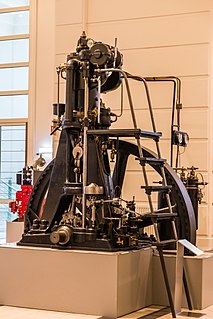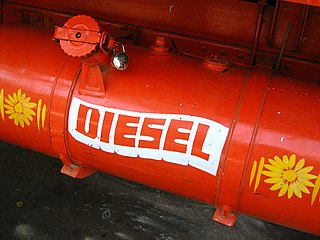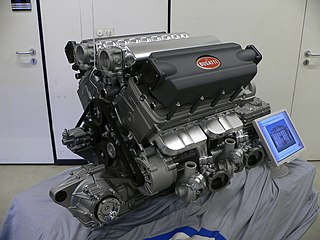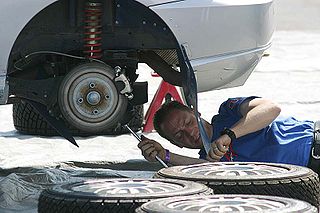
The diesel engine, named after Rudolf Diesel, is an internal combustion engine in which ignition of the fuel is caused by the elevated temperature of the air in the cylinder due to the mechanical compression; thus, the diesel engine is a so-called compression-ignition engine. This contrasts with engines using spark plug-ignition of the air-fuel mixture, such as a petrol engine or a gas engine.

Diesel fuel in general is any liquid fuel specifically designed for use in diesel engines, in which fuel ignition takes place, without any spark, as a result of compression of the inlet air mixture and then injection of fuel. Therefore, diesel fuel needs good compression ignition characteristics.

A petrol engine or gasoline engine is an internal combustion engine with spark-ignition, designed to run on petrol (gasoline) and similar volatile fuels.

A diesel locomotive is a type of railway locomotive in which the prime mover is a diesel engine. Several types of diesel locomotives have been developed, differing mainly in the means by which mechanical power is conveyed to the driving wheels.

The Mercedes-Benz E-Class is a range of executive cars manufactured by German automaker Mercedes-Benz in various engine and body configurations. Produced since 1953, the E-Class falls midrange in the Mercedes line-up, and has been marketed worldwide across five generations.

A diesel–electric transmission, or diesel–electric powertrain is a transmission system for vehicles powered by diesel engines in road, rail, and marine transport. Diesel–electric transmission is based on petrol–electric transmission, a very similar transmission system used for petrol engines.
Detroit Diesel Corporation(DDC) is an American diesel engine manufacturer headquartered in Detroit, Michigan, United States. It is a subsidiary of Daimler Trucks North America, which is itself a wholly owned subsidiary of the German Daimler AG. The company manufactures heavy-duty engines and chassis components for the on-highway and vocational commercial truck markets. Detroit Diesel has built more than 5 million engines since 1938, more than 1 million of which are still in operation worldwide. Detroit Diesel's product line includes engines, axles, transmissions, and a Virtual Technician service.

Cummins Inc. is an American multinational corporation that designs, manufactures, and distributes engines, filtration, and power generation products. Cummins also services engines and related equipment, including fuel systems, controls, air handling, filtration, emission control, electrical power generation systems, and trucks.

An auto mechanic is a mechanic with a variety of automobile makes or either in a specific area or in a specific make of automobile. In repairing cars, their main role is to diagnose the problem accurately and quickly. They often have to quote prices for their customers before commencing work or after partial disassembly for inspection. Their job may involve the repair of a specific part or the replacement of one or more parts as assemblies.
Clessie Lyle Cummins was the founder of the Cummins Engine Co. He was an entrepreneur who improved on existing diesel engines, created new diesel engine designs, was awarded 33 United States patents for his inventions, and set five world records for endurance and speed for trucks, buses and race cars.

Machinist's mate is a rating in the United States Navy's engineering community.
The 19th International 500-Mile Sweepstakes Race was held at the Indianapolis Motor Speedway on Saturday, May 30, 1931. Race winner Louis Schneider, who led the final 34 laps, was accompanied by riding mechanic Jigger Johnson.
A hybrid train is a locomotive, railcar or train that uses an onboard rechargeable energy storage system (RESS), placed between the power source and the traction transmission system connected to the wheels. Since most diesel locomotives are diesel-electric, they have all the components of a series hybrid transmission except the storage battery, making this a relatively simple prospect.

Industrial Training Institutes (ITI) and Industrial Training Centers (ITC) are post-secondary schools in India constituted under Directorate General of Training (DGT), Ministry of Skill Development and Entrepreneurship, Union Government to provide training in various trades.

Chamberlain was a brand of tractors from Australia, produced initially by Chamberlain Industries Ltd.
...to produce a tractor entirely suited to the large land holdings of Australian farmers... — Melbourne engineer A.W. (Bob) Chamberlain in the 1930s

The Mercedes-Benz V-Class is a hatchback (M) produced by Mercedes-Benz. It is available as a standard panel van for cargo, or with passenger accommodations substituted for part or all of the load area.

Various scientists and engineers contributed to the development of internal combustion engines. In 1791, the English inventor John Barber patented a gas turbine. In 1794 Thomas Mead patented a gas engine. Also in 1794 Robert Street patented an internal-combustion engine, which was also the first to use the liquid fuel (petroleum) and built an engine around that time. In 1798, John Stevens designed the first American internal combustion engine. In 1807, French engineers Nicéphore and Claude Niépce ran a prototype internal combustion engine, using controlled dust explosions, the Pyréolophore. This engine powered a boat on the Saône river, France. The same year, the Swiss engineer François Isaac de Rivaz built and patented a hydrogen and oxygen powered internal-combustion engine. The fuel was stored in a balloon and the spark was electrically ignited by a hand-operated trigger. Fitted to a crude four-wheeled wagon, François Isaac de Rivaz first drove it 100 meters in 1813, thus making history as the first car-like vehicle known to have been powered by an internal-combustion engine. In 1823, Samuel Brown patented the first internal combustion engine to be applied industrially in the U.S.; one of his engines pumped water on the Croydon Canal from 1830 to 1836. He also demonstrated a boat using his engine on the Thames in 1827, and an engine-driven carriage in 1828. Father Eugenio Barsanti, an Italian engineer, together with Felice Matteucci of Florence invented the first real internal combustion engine in 1853. Their patent request was granted in London on June 12, 1854, and published in London's Morning Journal under the title "Specification of Eugene Barsanti and Felix Matteucci, Obtaining Motive Power by the Explosion of Gasses". In 1860, Belgian Jean Joseph Etienne Lenoir produced a gas-fired internal combustion engine. In 1864, Nicolaus Otto patented the first atmospheric gas engine. In 1872, American George Brayton invented the first commercial liquid-fueled internal combustion engine. In 1876, Nicolaus Otto, working with Gottlieb Daimler and Wilhelm Maybach, patented the compressed charge, four-stroke cycle engine. In 1879, Karl Benz patented a reliable two-stroke gas engine. In 1892, Rudolf Diesel developed the first compressed charge, a compression ignition engine. In 1926, Robert Goddard launched the first liquid-fueled rocket. In 1939, the Heinkel He 178 became the world's first jet aircraft. In 1954 German engineer Felix Wankel patented a "pistonless" engine using an eccentric rotary design.

The DBAG Class 605, commonly known as the ICE TD is a high-speed diesel multiple unit (DMU) train, formerly in service with Deutsche Bahn and DSB.

A small engine is the general term for a wide range of small-displacement, low-powered internal combustion engines used to power lawn mowers, generators, concrete mixers and many other machines that require independent power sources. These engines often have simple designs, for example an air-cooled single-cylinder petrol engine with a pull-cord starter, capacitor discharge ignition and a gravity-fed carburettor.

The Dodge LCF was a series of medium- and heavy-duty trucks built by Dodge from 1960 until 1976. They replaced the Dodge Forward Look range of cabover trucks built in the 1950s. The 500 through 700 series were medium duty only, while 800 through 1000 series were reserved for heavy-duty versions.
















